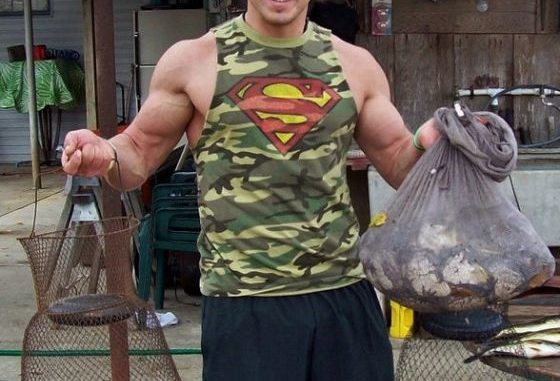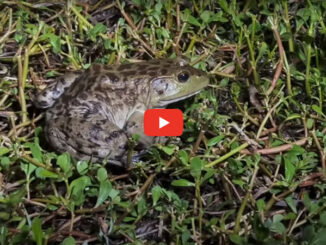
The right equipment is key to a successful trip
When it comes to frogging, having the best gear will definitely put more legs in the pot. These cold-blooded critters only pump hot blood during the summer months, allowing them to jump at even the slightest hint of danger.
The best gear will help you spot and snatch that big yellow-throated daddy or white-bellied monster momma frog before he or she expects a thing.
The best strategy in many instances is a good frog net. I grew up frogging with a heavy wooden net that only reached out nine feet and had no flexibility. (I even wrapped the entire pole in electric tape after getting fed up with splinters every trip.) Now I’m rigged up with the ultimate accomplice: a custom-made, lightweight aluminum telescoping frog net. And, the frame is bendable to adjust to any angled bank a frog may be perched on. If a frog is on a flat mud structure, I take no chances and get them with my new 17- foot-long net: it’s nearly twice as long, yet twice as light, as my wooden one. Of course, many times the frogs are already in the water. That’s when I incorporate my favorite style of frogging: the jumping hand grab. To catch the frog, I become the frog, leaping head first right on them. Remember, out there right now it’s not easy to approach a frog like it is in the wintertime. During the summer, I actually use this method to catch wary frogs that won’t let you get close. Unfortunately, I usually come home from a summertime trip busted up from underwater stumps and head-first body launches into the muck. But for me, grabbing a frog so big that I have to use both hands is worth a few bruises and a mouthful of mud. I put my frogs in a large mesh laundry bag or fish basket, but be aware that sometimes they can wiggle out of a basket. Large bags can easily hold 100 frogs, and with it zippered up or the drawstring cinched tight, there is never a worry about frogs escaping. Remember, you can only catch a frog if you see a frog, so I have several tricks to achieve the best possible lighting. Durability and mobility of your equipment are two important features that will help your lighting situation. Your light should be lightweight, water resistant, portable and shockproof. Regular bulky spotlights that use cords connected to batteries just don’t cut it. They end up getting broken or the cord gets tangled in the boat. To prevent this, I purchased a Black & Decker handheld LED spotlight for under $20 at Walmart. It runs on four AA batteries, and lasts about ten hours. (And I use rechargeable batteries, so I never waste money.) Beware that many cordless rechargeable lights have less than 20 minutes of running time, which doesn’t work well for frogging. My spotlight has one strong level which throws out a very condensed beam. Some larger lights illuminate a very wide cone, which makes it harder for me to concentrate: I prefer a tighter beam so I can focus on the frogs more intently. Another advantage is mobility. I can get out of the boat and go investigate a coulee in the swamp without having to rely on a much weaker headlamp. And with one extra set of rechargeable batteries for backup, I can easily frog all night with my spotlight. Next, it is important to get a really nice, comfortable headlamp. Many headlamps out there are big and bulky, and run off AA batteries or corded battery packs. But many small LED headlamps throw out a beam so tiny you can barely see your own feet. Luckily, I’ve found one that has is small but packs lots of power. I use a 155-lumen, 4.1-ounce Lenzer H7 headlight. It’s waterproof, shockproof and costs less than $25. It runs off of three rechargeable AAA batteries which last for up to four hours on high power and more than 60 hours on low power. You’ll forget you even have it on, and it also works like a headband to keep the sweat out of your eyes as you chase frogs. It extends a beam 180 meters and exceeds the performance of all the other larger headlights I’ve ever owned.
Once you’ve got your lighting situation handled, you’ll need to find areas that have very little vegetation. This is the most challenging part of frogging in the summer, when green overgrowth practically covers entire banks. Scouting during the day will save you valuable time and help you make the most of every trip. One thing I pay close attention to is rainfall totals and water levels in areas I like to frog. When the water drops enough to show mud edges that are usually covered by water, I know that I can go frogging in weedy areas, too. Even though frogging opens up in June for the summer, the drier months of August and September typically bring more frogs from the waterless swamps to the bayou’s edges. Many over-hunted spots early in the season will come back to life with big frogs and boat-less canals. Being that you’ll need boat lights, I have a trick if you use those inexpensive lights that often break. I keep a small 99-cent AA LED flashlight in my dry box. If the portable bow or stern light breaks, the bulb burns out or the batteries die, just slip the small flashlight into the empty D battery section of the portable light, and you’ll be able to navigate home safely. Also, during the warmer months, I find going after the frogs later in the night gives you a better chance at success. Once the big boys start filling their bellies with prickly crawfish, they become less likely to jump. But keep in mind that going later means you may be frogging an area that was already frogged earlier that night. Just travel to more distant locations, and this is rarely an issue. One of my favorite foods is frogs, but when my wife told me she didn’t care for them because the meat was tough, I instantly knew what happened. Being from out of state, she had only tried fried frog legs at restaurants. I think many restaurants under-season the legs, and as far as texture goes, frying is one of the worst ways to cook them. Smoking, barbecuing, or grilling is a great way to go, but my favorite cooking method is smothering them.
So I took out my skillet and some fresh bullfrog legs and got busy. In no time, my wife was loving smothered boneless frog legs, with great seasoning soaked up by the tender meat. Covering the legs after sautéing them in olive oil and onions will have the meat literally falling off the bone within 20 minutes. And adding a dash of wine, Lea & Perrins chicken marinade, or chicken broth with your seasonings will provide extra moisture. My biggest problem now is catching enough swamp toads to satisfy her now insatiable frog-loving appetite.


